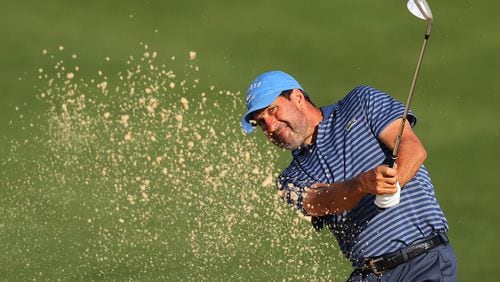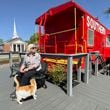A two-time Masters champion, Jose Maria Olazabal, at 51, should be well into the comfortable second chapter that is the PGA Tour Champions. And, yet, by necessity, he has become something of an expert at armchair golf.
Watching is never as much fun as doing. But it can have its rewarding moments. As when Olazabal was sitting back at the home he rented in Augusta last week, watching friend/countryman/protégé Sergio Garcia win the Masters in overtime.
It was almost as if Olazabal were riding shotgun with Garcia as he drove the hairpins and dips and mountain passes of Sunday’s final round. When Garcia struggled through Amen Corner, it was Olazabal who was praying. When Garcia missed the clinching 5-footer on the 72nd hole, Olazabal groaned. When his birdie on the 73rd hole won a long overdue major, Olazabal could almost feel the lining of the green jacket as his buddy slipped a first arm into the sleeve. It’s a Spanish thing.
“You go through all the moments,” Olazabal said.
“Happiness and relief for him because I know what he has been through,” he said, underscoring the emotions at the top of his list. “He’s a good kid and he’s been through a lot. He’s had close calls in majors, and then the media has sometimes been a little bit harsh on him, especially at home. Mainly happiness for him and his family.”
The Spanish-language feel-good stories in golf do not all begin and end these days with Garcia. Olazabal is writing his own entry.
A year ago at the Masters, too pained by a brand of arthritis that practically left Olazabal a prisoner in his home back in Spain, he could not even travel for the champions dinner, let alone play. All he could do was write a letter, to have it read in his absence to the room of past winners.
But this year, having found a medication that largely solved a long and perplexing mystery of his condition, he made his return to Augusta and ate with the eagles. And even played.
First a Tuesday practice round with Garcia, after which he suggested he’d be happy to share a locker with him in the champions’ corner of the Augusta National clubhouse. (Translation: Go out and win the thing already).
And then in the tournament itself. Nothing to set the place abuzz — 77-76-missed cut. But did that really matter?
“It’s great, it’s fantastic to be part of that event. Every time I drive through Magnolia Lane you have wonderful memories of years past,” he said.
And a year after his 50th birthday, he finally is cashing in on his chance to play with somebody his own age on the PGA Tour Champions. The Mitsubishi Electric Classic, beginning Friday at Duluth’s TPC Sugarloaf, will be Olazabal’s fourth appearance on the over-50 Tour, where no one seems to begrudge another snout at the trough.
“It’s fantastic that he’s back,” said another Masters-made man, Bernhard Langer. “We’ve missed him. I love that guy. A real trooper. Great champion. Great ambassador of the game. Just very happy that he is well enough to compete again and be out here.”
After bugging out of the 2015 Masters after the second round, Olazabal remained mostly unseen until his return to the course for the British Masters in October, 2016. It was his second prolonged absence from golf, having missed 18 months in the mid-1990s with a foot ailment whose origins eventually were traced to his back.
During this latest 18-month health scare, the pain in Olazabal’s joints reached a point that even if he could unscrew the cap from a bottle of water, he’d have difficulty raising it to his lips. He was a virtual shut-in, leaving him a lot of time to watch golf on TV, including the Champions tour that now was beginning to pass him by.
“When I was at my lowest (around December 2015), golf was out of the equation completely,” Olazabal said. “I couldn’t do a normal life, I couldn’t do nothing at all. Many, many times I thought golf was over if the situation didn’t reverse.”
As a new round of medication began to lift the fog of pain, Olazabal dared to begin hitting balls again at the end of last summer. First just wedges, and not very pretty ones at that. “First few balls, I could get proper contact,” he said, topping and chunking them like a novice (at least in his eyes).
Dipping his toe back into competitive golf, he missed the cut in four European Tour events. On the over-50 circuit, he has finishes of 41st, 40th, and 61st. Not that he’s really counting at this point.
“It’s rusty,” he said of his game. “I’m trying to regain form. I see some signs on the driving range but because of lack of competition it’s tough to do it on the golf course. It will come, sooner or later. Hopefully sooner.”
“It’s very nice, nice to see him coming back, nice to see how he’s hitting the ball,” Miguel Angel Jimenez, his fellow Spaniard of the Champions tour, said. “Time will tell. The game is there. It is coming.”
So, Olazabal wakes up in the morning and he knows he’s not 20 anymore. He’ll take his inventory on what is feeling good that day and what isn’t. So long as he can make it to the practice range, it’s always a net physical profit.
“Coming from the situation I’ve been through the last couple years, everything is a positive sign,” he said. “Being able to be active and practice a bit and play golf, that’s already a positive — every day. I’ll stick to that,” he said.
Because, every day is a good day when you can treat golf as a verb rather than a noun.
About the Author







